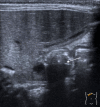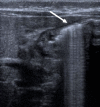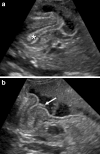Hypertrophic pyloric stenosis: tips and tricks for ultrasound diagnosis
- PMID: 22696086
- PMCID: PMC3369120
- DOI: 10.1007/s13244-012-0168-x
Hypertrophic pyloric stenosis: tips and tricks for ultrasound diagnosis
Abstract
We describe a systematic approach to the ultrasound (US) examination of the antropyloric region in children. US is the modality of choice for the diagnosis of hypertrophic pyloric stenosis (HPS). The imaging features of the normal pylorus and the diagnostic findings in HPS are reviewed and illustrated in this pictorial essay. Common difficulties in performing the examination and tips to help overcome them will also be discussed. Main Messages • Hypertrophic Pyloric Stenosis is defined by thickening of the muscular layer and failure in relaxation of the pyloric canal. • The main diagnostic criterion is a measurement of more than 3mm in thickness of the muscular layer. • Abnormal elongation of the canal is characterised as greater than 12 mm in length.
Figures







References
-
- Ohshiro K, Puri P. Pathogenesis of infantile hypertrophic pyloric stenosis: recent progress. Pediatr Surg Int. 1998;13:43–252. - PubMed
LinkOut - more resources
Full Text Sources

